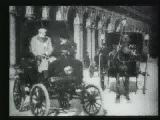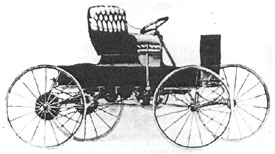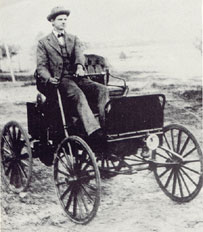North
Carolina
Business
History
North Carolina did not have any major manufacturers of automobiles in the early 20th century, although there were a few companies and numerous individuals who built some cars or motorized buggies — the most significant being Corbitt Automobile Company (1905 - 1952).





The first automobiles began appearing in North Carolina around 1898. In 1900, Gilbert S. Waters viewed autos on a trip to Baltimore. He worked with his father in a successful buggy manufacturing business in New Bern — G.H. Waters & Sons Buggy & Carriage Factory. Gilbert took one of their buggies and added a engine to build an initial horseless carriage in 1900. He built a second car in 1903 and tried to interest his father and local investors in launching an auto manufacturing business. At the same time, Henry Ford was demonstrating his auto and getting financial backing in Detroit. Waters was unsuccessful in interesting supporters and the idea died stillborn.
In Reidsville, another successful buggy maker — Fletcher Waynick — built a car in 1902, once again using one of his buggy bodies. Waynick built three more buggymobiles between 1902 and 1905, but never got a real auto manufacturing business going.
The practice of using existing buggy models led to the early coinage of horseless carriage or buggymobile for early cars.
Richard J. Corbitt had moved to Henderson, NC, in 1899 and created a very successful buggy manufacturing business. In 1905, he successfully sought additional capital to expand the Corbitt Buggy Company to convert one of his three factory buildings into auto production.
In 1907, the first Corbitt Motor Buggy was produced by the renamed Corbitt Automobile
 Company —
a high-wheeled, chain-driven buggy
with an engine. In 1908, Corbitt added fenders to the car, and in 1909 he
added acetylene lamps. In 1910, Corbitt advertised nationally a $800
touring car with a two-cyclinder, 18 to 20 horsepower engine on a 90-inch
chassis, as well as a two-passenger Model B runabout.
Company —
a high-wheeled, chain-driven buggy
with an engine. In 1908, Corbitt added fenders to the car, and in 1909 he
added acetylene lamps. In 1910, Corbitt advertised nationally a $800
touring car with a two-cyclinder, 18 to 20 horsepower engine on a 90-inch
chassis, as well as a two-passenger Model B runabout.There were about 2,400 automobiles in North Carolina in 1910. At that time, there were 600 generally small automobile manufacturers in the U.S.
By 1912, Corbitt had redesigned the cars that were now 120-inch wheel base with a four-cyclinder, 30 horsepower engine costing $1,750 for the roadster and $2,000 for the touring car (Model 4p). Over these years, Corbitt built and sold more than 100 cars in all probabililty.
By Henry Ford was gearing up his assembly line factory system — in 1914 Ford produced 300,000 cars compared to the rest of the industry which produced 200,000 cars. With lowering prices on the Ford product, the great elimination of auto makers began. For example, Ford established a Charlotte, NC, branch that initially supplied parts to dealers and assembled Ford cars (6,850 autos in 1915 up to 100,000 autos in 1927).
Corbitt recognized the trend and last produced a car in 1914 — with a four-cyclinder, 26-horsepower engine.
In 1915, the Corbitt company was renamed the Corbitt Motor Truck Company which would continue to successfully produce trucks until 1952.
Among early motor car or truck manufacturers/builders in North Carolina were:
Asheville
Asheville Light Car Company (1914-1915) - E.C. Merrell (or Merrill) established the company in 1914 to produce a light-weight, simple vehicle, really just a "cycle car." The Asheville Light Car was a 2-seater with minimal body structure, weighing only 450 pounds and propelled by 7-horsepower, Indian (Motorcycle) twin-cylinder engine. The wheelbase was 94 inches.
The tiny one- or two-seat cyclecars were introduced in 1913 at a national car show as a low-cost alternative to a "regular" automobile and they quickly became a fad that peaked in 1914. By 1915, the fad was over and no cyclecars were exhibited at national auto shows.
At least one Asheville Light Car was produced.
Carthage
Tyson and Jones Buggy Company - a successful buggy manufacturer, this firm belatedly attempted to manufacture truck bodies in 1924, but there has been no confirmation that it did so.
Conover
Jerome Bolick Sons Company (1934 - 1978) - began manufacturing school bus bodies in 1934, switching to truck bodies in 1953. The firm ceased production in 1978.
Greensboro
American-Southern Motors Corp. (1920-1921) - an assembler of the American-brand car (1916-1922) manufactured in Plainfield, New Jersey, by the American Motors Corp. (no connection with the firm of the same name during the mid-century). A factory was built on West Second Street in Greensboro. At least one "American Balanced Six" model (six-cyclinder, black sedan) was assembled and sold.
In 1921, American-Southern Motors proposed to build and sell the Vaughn car, named after and financed by Greensboro banker Robert G. Vaughn. There were two planned models -- a four-cyclinder Dusenburg engine for a 5-seater and a larger car (7-seats) with a 12-cyclinder Weidley engine.
The four-cyclinder car model was launched at a "Made in Carolinas" Exposition in Greensboro in Sept. 1921. The seven-passenger car was a sport-touring model powered by a Weidley V12 engine with a wheelbase of 127 inches. The car weighted almost 5,000 pounds and was priced at $3,995. In Spring 1923, the company (now known as Irving Automobile Co. as of December 1921, a dealership) proposed a new, lower-priced Vaughn car. After prototypes, production never commenced.
Southern Truck and Car Company (1918 - 1925) - Despite the name, this firm was an assembler of trucks and apparently did not build any cars.
Henderson
Corbitt Automobile Co. (1911 - 1914) and Corbitt Motor Truck Co. (1915 - 1952) — Richard J. Corbitt (1876 - 1955) founded the motor vehicle company after building his first car in 1907, according to reports. He had founded another business in 1899. The first truck was built in 1913. Finding an opportunity in truck production, by the 1920s, then firm was known as Corbitt Motor Truck Co. The firm produced 5-ton trucks, adding up to 15-ton trucks in the 1930s. Military and civilian trucks were produced during World War II. Volume production by the company ceased in 1952, when the then 76-year-old Richard Corbitt retired. An attempt was made in 1957 to revive the business with a build-on-order approach, but it was short-lived.
High Point
Thomas Built Buses ( - present) - Built bus bodies, as well as some trolley car bodies.
New Bern
Gilbert S. Waters (1900 - 1903) - He built a Buggymobile around 1900 with a one-cyclinder, water cooled engine and pneumatic tires. He built another auto in 1903 and tried to get investors to expand the G.H. Waters & Sons Buggy & Carriage Factory into the auto manufacturing business, but failed to win financial support.
Reidsville
Waynick's Carriage Shop (1902 - 1905) - Fletcher Waynick built four motor cars between 1902 and 1905. The first car had a five-horsepower, single-cylinder gasoline engine mounted on a buggy body. His company, Waynick's Carriage Shop, never got very active in auto production, although Fletcher continued to experiment, including construction in 1915 of an auto built of parts of various cars.
Rock Hill (SC)
Anderson Automobile Company (1919 - ) - Formed by John Anderson from his gatherfather's successful buggy manufacturing business in 1919, the new firm produced up to 35 cars a day. Anderson left his home in Lawsonville, NC, in the 1880s to join his grandfather's buggy firm.
Wilson
Hackney Brothers (1854 - 1996) - Although it started as a wagon building business in 1854 and turned out about 200 buggies and 100 wagons a year by 1885. The firm began making truck bodies in 1910s, later expanding the company's product line to include ambulances, house trailers, hearses, portable storage rooms, temporary bleachers, car-top sleepers, and school buses. The company patented the first carbon dioxide-based refrigeration system in 1931. Refrigerated trucks became their most important product. It was sold in 1993 to Hackney & Sons located in Washington, NC. Then in 1997, TTI bought the entire Hackney firm and merged its operations with another subsidiary, Kidron.
Among the planned manufacturing firms that never became operational or built any cars were:
Consolidated Motor Car Company (Lafayette, NC) - 1911
Durham Automobile Company (Durham, NC) - 1909 (no record of ever building a car)
Greensboro Motor Car Company (Greensboro, NC) - 1911 (probably remained a garage and dealership)
Wizard Automobile Company (Charlotte, NC) - 1920; produced a prototype Wizard Junior car -- 2-cyclinder, 15 horsepower engine, 100-inch wheelbase, 800 lbs. A five-passenger Wizard Senior car was promoted by never built. By 1921, the firm collapsed and the firm's secretary had departed with all funds.
Please provide any additional information for this list to Ron Vinson.
Parade choose (one) your
most appropriate format:
Click for 1 min. QT movie (4.4M)
Click RealMedia movie (2.7M)
Click Windows Media Video (1M)
Download and buffering these
files may take a a moment.

1900 Buggymobile built by
Gilbert S. Waters of New Bern

1902 auto built by Fletcher
Waynick of Reidsville
1907 automobile (at left) built
by the Corbitt Automobile
Company.
NC Carriage/Buggy Makers
Industries Laureates Contact
Us Home
2007 Copyright. CommunicationSolutions/ISI
for web site and content.